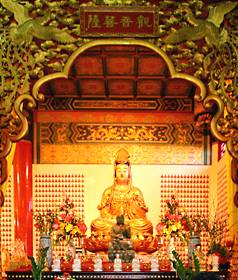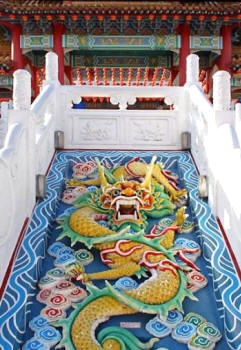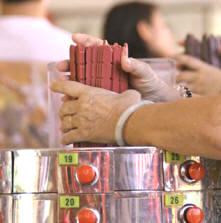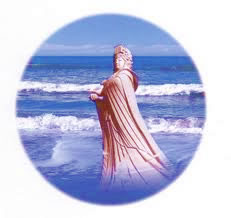Thean Hou Temple ~ Places to Visit in
Kuala Lumpur
KL Visitors Guide
HOME >
VISITORS
GUIDE > PLACES TO
VISIT >
KL CITY CENTRE > TIAN HOU TEMPLE
Sitting atop a hill, the
Thean Hou Temple with elements of Buddhism, Taoism and Confucianism,
features traditional and contemporary Chinese architectural design. With
decorative beams, spectacular roofs, ceilings, calligraphic couplets, and
murals, the temple is dedicated to the patron Goddess Thean Hou of the
Hainanese community.
This grand structure has made it a popular tourist
destination and a place to relax and enjoy the panoramic
view of the temple set against the city's skyline.
 Thean Hou Temple in
Kuala Lumpur is one of the largest Chinese temples in South-East Asia.
Thean Hou Temple in
Kuala Lumpur is one of the largest Chinese temples in South-East Asia.
The
front entrance of the temple features a multi-arched gateway with red
pillars, the colour symbolic of prosperity and good fortune.
Souvenir stalls
and a canteen are found on the 1st level. The 2nd level houses the
multi-purpose hall while offices are located on the 3rd level. The 4th level
has 3 tiers and the prayer hall is located here.
The prayer hall houses three altars, dedicated to Guan Yin (the Goddess of
Mercy), Tian Hou (Empress of the Sky) and Shui Wei Sheng Niang (the Goddess
of the Waterfront).
 Despite
the dedication to Thean Hou (or Tien Hou), worship of Guan Yin (or "Guan
Shi-Yin") is a recurrent theme here.
Despite
the dedication to Thean Hou (or Tien Hou), worship of Guan Yin (or "Guan
Shi-Yin") is a recurrent theme here.
In addition to her altar in the prayer
hall, there are also statues of Guan Yin set amongst rocks and falling
water. Here one can kneel and receive a blessing of water from the statue.
In the small garden at the front of the temple are interesting statues of
Guan Yin and the Three Wise Men (from right; The God of Longevity, he holds
a staff and a peach; The God of Wealth, he holds a sceptre sword; and, The
God of Happiness and Prosperity, he holds a child).
Opposite the temple,
there is a collection of other large statues that include representations of
the twelve animals of Chinese astrology
 Dragons
are prominently featured in this temple. At the 4th level, the courtyard has
a mural of a fierce dragon and the white pillars of the prayer hall are
decorated with writhing dragons. Its image is also seen on the walls and
roofs.
Dragons
are prominently featured in this temple. At the 4th level, the courtyard has
a mural of a fierce dragon and the white pillars of the prayer hall are
decorated with writhing dragons. Its image is also seen on the walls and
roofs.
The dragon was the most revered of all animals during ancient times
and is symbolic of life. It is a sign of vigilance, strength and goodness.
 Fortune Telling
Fortune Telling
Visitors can have their fortune told at the prayer hall. There are 3
'fortune telling' machines. Each machine consists of a cylindrical container
with small drawers around it.
Numbered sticks have been placed in the
container. You will need to draw up the whole bundle of sticks and drop them
back into the container. The sole stick that sticks out is your 'luck'. You
then match the number on the stick with the appropriate drawer. Each drawer
contains pink slips of paper with the fortune told in Chinese and English.
 Celebrations
& Festivals
Celebrations
& Festivals
Thousands of people visit the temple every year to offer prayers to the
three deities.
Apart from being a place of worship, the temple is also a
place for cultural activities. It hosts an average of 100 activities
annually.
Among them are the grand birthday celebrations for Thean Hou
Goddess, Kuan Yin and the Goddess of the Waterfront, Dharma Prayers, Wesak
Day, Mooncake Festival and the 15-day Chinese New Year celebration. The
Thean Hou Goddess birthday celebration at the temple is touted as the
biggest ever held outside China.
Newlyweds are frequently seen here as the temple provides a lovely location
for video filming and picture taking. Couples wishing to get married can
have their marriage registered and solemnised here and multi-purpose hall on
the 2nd level is available for the wedding reception and dinner.
The Thean Hou Legend
Lin Mo was said to have been born on the 23rd day of the 3rd month of the lunar calendar in
960AD (Song Dynasty). The baby was given the name Mo (silence) because as a
newborn she never cried. She grew up in Meizhou Islands off Putian in Fujian
and died on the 9th day of the 9th lunar month in 987AD at the age of 27.
 Lin
Mo was always lending a helping hand to villagers who were in difficulties
and thus gained love and respect for her many good deeds. Her knowledge of
herbal medicine enabled her to cure the sick and she taught the villagers
how to prevent diseases and ward off calamities. She was also familiar with
the sea and was good at making astronomical observations and calculating
weather changes. Lin Mo could tell when was the right time for sailors and
fishermen to go to sea.
Lin
Mo was always lending a helping hand to villagers who were in difficulties
and thus gained love and respect for her many good deeds. Her knowledge of
herbal medicine enabled her to cure the sick and she taught the villagers
how to prevent diseases and ward off calamities. She was also familiar with
the sea and was good at making astronomical observations and calculating
weather changes. Lin Mo could tell when was the right time for sailors and
fishermen to go to sea.
As her reputation spread and grew, so did the myths. It was said that she could ride
the clouds across the ocean, and many times used her powers to save merchant
ships and fishing boats. She was honoured several titles by different
emperors of different dynasties - Song, Yuan, Ming and Qing. During the Qing
Dynasty, she was ans was known as Tian Fei (Heavenly Princess), Tian Hou (Heavenly
Empress) and Tian Shang Sheng Mu (Divine Mother of Heaven). She is also known
as Ma Zu (or Ma Zhou and Matsu), Tian Hou Niang Niang and also, Ma Hou.
She is now worshipped as a sea goddess by Southern Chinese fishermen. No
fisherman would leave the shore without invoking her blessings (for a safe
voyage) and none would forget offering thanks after his safe return.
The statue of Tian Hou is normally accompanied by images of her 2
assistants, General Chien Li Yen (Eyes That See a Thousand Miles) and
General Shun Feng Erh (Ears That Hear the Wind).
Note
Visitors are to remove their footwear before entering the Temple.
Best Way to Visit - Take City Tour
A Full or a Hulf day private tour that allow a visit here and other places of
interests of your preference.
 PLACES & SIGHTSEEING ~ KL CITY CENTRE
PLACES & SIGHTSEEING ~ KL CITY CENTRE
CHINATOWN CENTRAL MARKET JAMEK MOSQUE MARIAMMAN TEMPLE
THEAN HOU TEMPLE
PETRONAS TWIN
TOWERS KL TOWER
INDEPENDENCE
SQUARE
KINGS PALACE
CHAN SEE SHU YUEN
TEMPLE


 Thean Hou Temple in
Kuala Lumpur is one of the largest Chinese temples in South-East Asia.
Thean Hou Temple in
Kuala Lumpur is one of the largest Chinese temples in South-East Asia.
 Despite
the dedication to Thean Hou (or Tien Hou), worship of Guan Yin (or "Guan
Shi-Yin") is a recurrent theme here.
Despite
the dedication to Thean Hou (or Tien Hou), worship of Guan Yin (or "Guan
Shi-Yin") is a recurrent theme here.
 Dragons
are prominently featured in this temple. At the 4th level, the courtyard has
a mural of a fierce dragon and the white pillars of the prayer hall are
decorated with writhing dragons. Its image is also seen on the walls and
roofs.
Dragons
are prominently featured in this temple. At the 4th level, the courtyard has
a mural of a fierce dragon and the white pillars of the prayer hall are
decorated with writhing dragons. Its image is also seen on the walls and
roofs.
 Fortune Telling
Fortune Telling Celebrations
& Festivals
Celebrations
& Festivals Lin
Mo was always lending a helping hand to villagers who were in difficulties
and thus gained love and respect for her many good deeds. Her knowledge of
herbal medicine enabled her to cure the sick and she taught the villagers
how to prevent diseases and ward off calamities. She was also familiar with
the sea and was good at making astronomical observations and calculating
weather changes. Lin Mo could tell when was the right time for sailors and
fishermen to go to sea.
Lin
Mo was always lending a helping hand to villagers who were in difficulties
and thus gained love and respect for her many good deeds. Her knowledge of
herbal medicine enabled her to cure the sick and she taught the villagers
how to prevent diseases and ward off calamities. She was also familiar with
the sea and was good at making astronomical observations and calculating
weather changes. Lin Mo could tell when was the right time for sailors and
fishermen to go to sea.